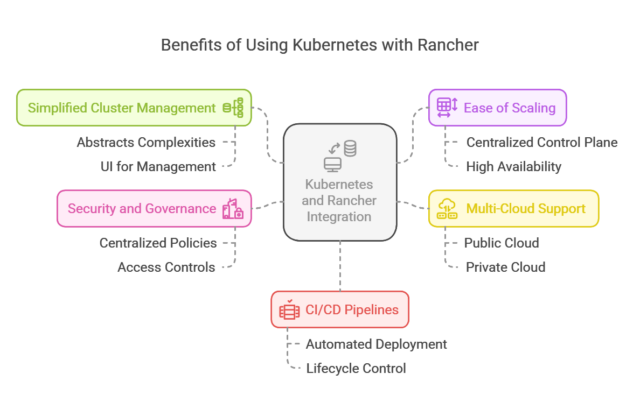Introduction:
The world of cloud-native applications is growing, and with this growth comes the challenge of effectively managing large-scale containerized applications. Kubernetes and Rancher are two powerful, open-source tools that have revolutionized container orchestration. Together, they offer seamless management of containerized workloads, scalability, and resilience. In this blog, we will explore how Kubernetes and Rancher address the challenges of orchestration, and why they are indispensable in modern DevOps and cloud-native environments.

What is Kubernetes?
Kubernetes, often referred to as K8s, is an open-source container orchestration platform that automates the deployment, scaling, and management of containerized applications. Originally developed by Google, Kubernetes has become the industry standard for container orchestration.
Key features of Kubernetes:
- Self-healing: Automatically replaces containers that fail, kills containers that don’t respond to your user-defined health check, and doesn’t advertise them to clients until they’re ready to serve.
- Horizontal Scaling: Kubernetes allows applications to scale up or down quickly and efficiently based on real-time demand.
- Load Balancing: Automatically distributes network traffic to ensure that no single instance becomes overwhelmed.
What is Rancher?
Rancher is an open-source multi-cluster Kubernetes management platform that simplifies the management of Kubernetes clusters across a variety of infrastructures. Rancher provides a user-friendly interface and an additional layer of management for Kubernetes environments, making it easier for teams to deploy, manage, and monitor their clusters.
Key features of Rancher:
- Multi-cluster Management: Rancher allows users to manage multiple Kubernetes clusters, regardless of whether they are running on-premises, in the cloud, or in hybrid environments.
- Centralized Authentication and Security: Rancher provides centralized security, with role-based access control (RBAC) and integrated identity management for teams.
- App Catalogs: Rancher’s App Catalog simplifies the process of deploying applications with pre-configured Helm charts.
Why Kubernetes and Rancher Together?
- Simplified Kubernetes Cluster Management: Kubernetes itself is highly powerful but also complex. Rancher abstracts away many of these complexities and provides a simpler UI for cluster management, making it ideal for teams with varying levels of Kubernetes expertise.
- Ease of Scaling: Kubernetes provides the infrastructure to scale applications up or down automatically but managing multiple Kubernetes clusters can be overwhelming. Rancher streamlines this process by offering a centralized control plane for all your clusters. You can easily scale applications across clusters, ensuring high availability and resource optimization.
- Multi-Cloud and Hybrid Cloud Support: Kubernetes is platform-agnostic, meaning it can run on any infrastructure. Rancher enhances this by supporting both public and private clouds. This flexibility allows businesses to deploy applications across multiple cloud environments and manage them centrally.
- Security and Governance: Kubernetes has a rich set of security features, including RBAC, namespaces, and secrets management. Rancher adds an additional layer of security by enabling centralized security policies and streamlining access controls across clusters.
- Continuous Integration/Continuous Deployment (CI/CD) Pipelines: Both Kubernetes and Rancher play an important role in CI/CD workflows. Kubernetes handles automated deployment, while Rancher facilitates better visibility and control over the lifecycle of these applications, allowing for easier monitoring and troubleshooting.

Key Use Cases for Kubernetes and Rancher
- Microservices Architecture: Kubernetes is highly effective at running microservices, where different components of an application are isolated in separate containers. Rancher makes it easier to manage multiple microservices across different Kubernetes clusters.
- Cloud-Native Applications: Businesses adopting a cloud-native approach will benefit from Kubernetes’ ability to orchestrate cloud-based applications. Rancher makes managing these applications at scale seamless and efficient.
- Edge Computing: Kubernetes and Rancher can be deployed in edge environments, which require containerized applications to be deployed closer to the end-user. Rancher simplifies edge computing by allowing users to manage Kubernetes clusters distributed across various locations.
Conclusion:
Kubernetes and Rancher are two open-source powerhouses that work in tandem to simplify and scale container orchestration. Kubernetes provides the necessary foundation for containerized application management, while Rancher complements it with powerful tools for managing multiple clusters and enhancing security. Together, they offer organizations a comprehensive solution for building, deploying, and managing cloud-native applications at scale.
